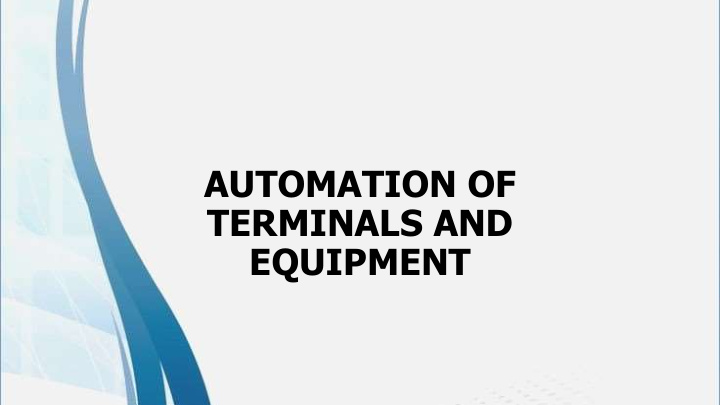



AUTOMATION OF TERMINALS AND EQUIPMENT
AUTOMATION OF TERMINALS AND EQUIPMENT • The Maritime Industry is currently undergoing a number of changes which focuses on digitalization and autonomation with the objective to keep up to pace with the latest developments or be left behind by competitors. • The only way to handle today’s huge ships and container exchanges on limited land is to automate marine terminals, e.g.: - Electronic Cargo Tracking System - Geo-Fencing
AUTOMATION OF TERMINALS AND EQUIP IPMENT • The use of automated guided vehicles to move containers from the vessel to the container stack and the use of rail-mounted automated stacking cranes (which replace diesel powered rubber tire gantry cranes) enables the terminal operator to stack containers higher in the yard and to efficiently retrieve the boxes for the stacks and deliver them to truckers.
IMPACT ON LABOUR • Automatic stacking cranes “robotic cranes” find and load containers onto a waiting truck – no human operator necessary. • Certain ports experimenting with robots, artificial intelligence and other digital tools. The technology is widely seen as the most efficient way. • “It doesn’t hurt that robots and algorithms don’t require breaks, weekends or health insurance.”
IMPACT ON LABOUR (CONT’D) • Whether automation in ports and terminals means heavy job losses or demand on work forces to retrain to acquire the skills necessary for modern digital operation. • • The view is that the effect on jobs will be minimal even negligible providing workers are retrained in dealing with software. • • Suggestion to tax robotic machinery that takes human jobs.
Automation of Information Flows • Digitizing maritime shipping data and making it available to cargo owners and supply chain operations though secure channelled access. The digital platform will provide logistics managers with greater line of sight and planning capabilities to more effectively service mega container vessels.
Modernization of Legal Framework • As digitization transforms the maritime landscape we need to manage cyber risks. • US: CYBER SECURITY INFORMATION SHARING AND COORDINATION IN OUR PORTS ACT • (Global cyber attack – virus leading to shutdown of port)
Recent Jamaican Legislation • THE CYBERCRIMES ACT, 2015 • An ACT to provide criminal sanction for the misuse of computer systems or data and the abuse of electronic means of completing transactions and to facilitate the investigation and prosecution of cybercrimes. • DATA PROTECTION ACT, 2017 • An act to safeguard individuals to exercise choice concerning direct marketing and automated decision-making, and rectify inaccuracies in personal data;
Recent Jamaican Legislations • Special Economic Zone (SEZ) Act, 2016 • Wharfage Act – Modernization? • Enablement for payment for Security and other increased operational costs • Customs Trade Partnership Against Terrorism (CEPAT) • Container Security Initiative
Modernization of Information Legislation • Port Information Portals • Modernization of Customs/Modernization of Customs Act • THE UNCTAD AUTOMATED SYSTEM FOR CUSTOMS DATA (ASYCUDA) • Is an integrated customs management system for international trade and transport operations in a modern automated environment. • • Advanced software applications are designed and developed for customs administrations and the trade community to comply with international standards when fulfilling import, export and transit related procedures.
ASYCUDA • Modernizing customs operations and helping to improve revenue collection • Facilitating trade efficiency and competitiveness by substantially reducing transaction time and costs • Improving security by streamlining procedures of cargo control, transit of goods and clearance of goods • Helping fight corruption by enhancing the transparency of transactions • Promoting sustainable development by cutting down on the use of paper, through the use of electronic transactions and documents.
Port Community System (PCS) • Platform to integrate all stakeholders of the supply chain – a single window environment for the port community • Central interface with Customs Management system and any Government single window • Transshipment processes can be seamless, with exceptions being easily identified and targeted. • Reduced paper usage and processing times • Improves security and traceability of transactions as all actions are electronic and registered.
Modernization of Security Systems • The Port Authority (Ports Management and Security), Regulations 2010 •
Recommend
More recommend